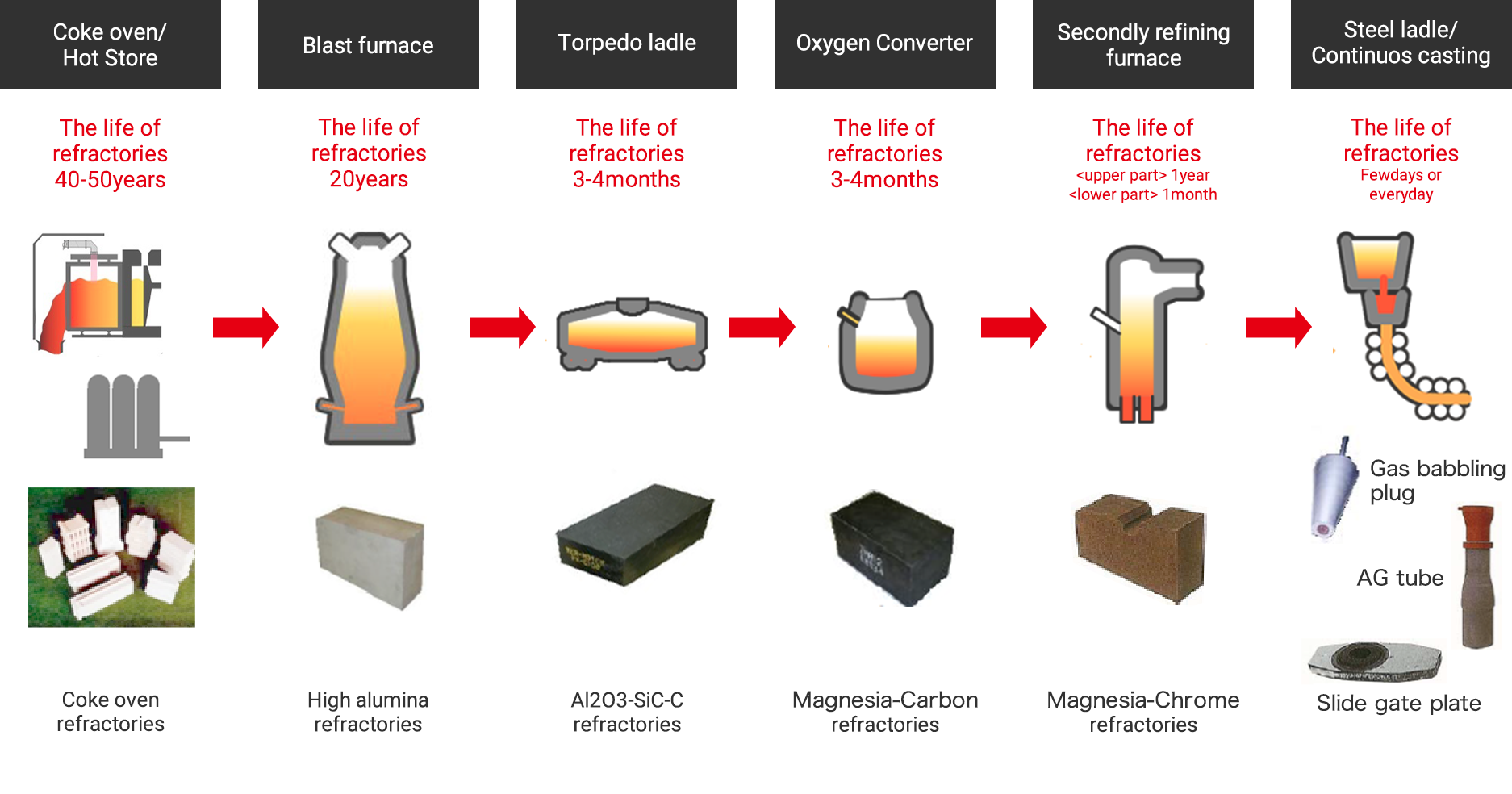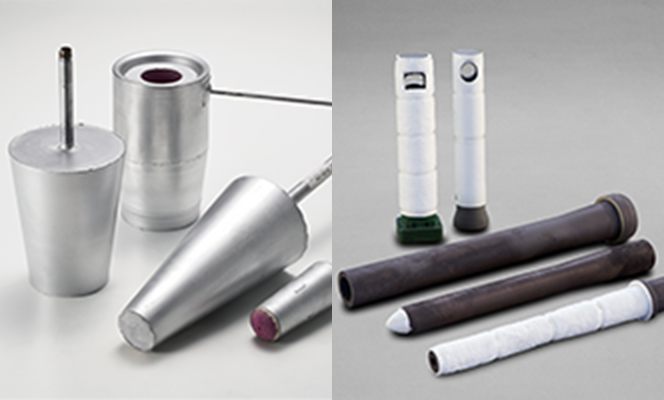BUSINESS
Refractory Business
Materials that can withstand very high temperatures and support the manufacture of the iron and steel that is the foundation of Japan’s iron and steel industry.
Materials such as iron, steel, cement and glass and the like are made under conditions of very high temperatures. The “material for the materials,” supporting manufacture in the toughest of conditions, at times approaching 2000℃, is refractories. The materials that pass through these processes are used in many of the everyday objects around us, such as automobiles, buildings, home appliances, mobile phones, beverage cans and cutlery.
Refractories are the material at the very foundation of Japanese manufacturing, indeed of our daily lives.
Iron and steel


Glass


Cement


Main customers
Iron and steel
-
-
JFE Steel Corporation
-
Kobe Steel, Ltd., and others
Cement
-
Mitsubishi Materials Corporation
-
Tokuyama Corporation and others
Meeting the needs of steelworks with stable quality refractories
Refractories are used in a wide range of processes in steelmaking, from blast furnaces to continuous casting. Therefore, more than anything, they need to have reliable quality.
The material for the materials that can withstand temperatures of well over 1000℃.
Iron/steel and other metals, glass, cement and other “materials” are always heated to temperatures ranging from several hundred to over one thousand several hundred degrees Celsius.
For instance, the melting point of iron is 1,538°C. The channels along which molten iron and glass travel, and the receptacle pans into which they flow, must be made of a material that is able to withstand such high temperatures as well as chemical erosion.
Refractories are used in such cases.
 Steel making process in steel manufacturer
Steel making process in steel manufacturer


What are the properties required of refractories?
- They must be able to withstand rapid temperature changes, without cracking or chipping.
- They must be physically robust, and not easily worn down.
- They must be chemically stable even under the kinds of high temperature conditions that hasten chemical reaction.
Main refractory product categories
-

Refractories for kilns
So-called “refractory bricks.” These are mainly used for inner lining.
-

Unshaped refractories
These refractories are shipped in powder form as mixed raw materials.
They can be mixed with water and kneaded into molds, or used to patch worn sections of refractories inside kilns.
Also, since there is no solidification process involved, this contributes to CO2 reduction, process shortening and cost reduction. -

Functional refractories
These refractories are mainly used in the continuous casting process of steelmaking. They are used in the flow control and rectification of molten steel and gas stirring, etc.
Krosaki Harima’s commitment to refractory manufacture
Iron/steel is used in many of the things that surround us in daily life, such as smartphones, PC, televisions and canned beverages, but, in actual fact, none of these things could exist without refractories.
And, the iron/steel also needs to be “high grade iron.”
High grade means the iron/steel is highly precise, having gone through very delicate quality governing, which is why it can be bent and worked in a very detailed way.
Krosaki Harima’s refractory manufacture is the very cornerstone of such highly precise materials. Refractories underpin the manufacturing industry and, indeed many of the things that surround us in our daily lives.
At “Krosaki Harima with Technology,” we will continue in the future to strive to be able to deliver the refractories that produce the very best materials.
*For details, see our Research and Development page.
 Refractory manufacturing flow
Refractory manufacturing flow
-
Blending the raw materials
From over 1,000 kinds of raw materials in a wide range of particle sizes, we carefully select the raw materials that are best suited to the product, blend them and create a recipe.
-
Weighing, mixing and kneading
Following the recipe, the raw materials are weighed, then mixed in a mixer to achieve a uniform consistency. Next, they are mixed with a liquid resin called a binder, and kneaded.
-
Forming
After kneading, the mixture is put into a mold and pressurized in a press to be formed into the product shape.
-
Firing
The formed product is then solidified by firing at temperatures of between 1200 to 2000℃.
-
Machining
Depending on the product, it will then be polished or bored, and have accessories added to it.
-
Inspection
Quality and external appearance are inspected by a variety of methods in order to check for any non-conforming product.
-
Sales
Our products are then sold to iron/steel, cement, glass and chemical product manufacturers, and plants that have incinerators, etc.
Overseas, we are also expanding our business into countries and regions where there are national initiatives to develop the iron/steel industry, principally in India and also Europe and North America.